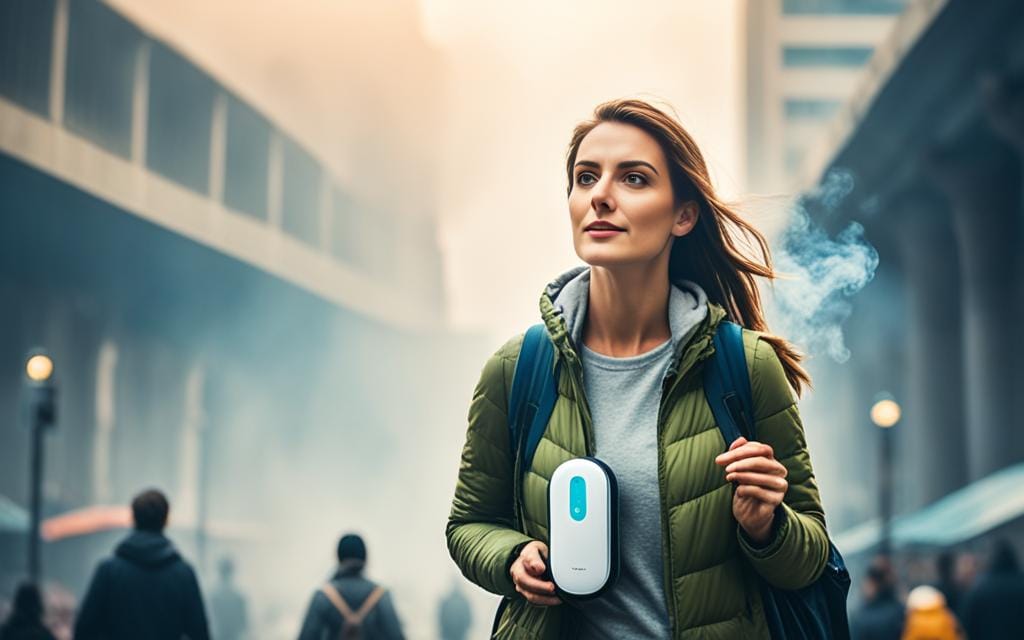Want to stay healthy while traveling? It’s important to fight air pollution. We’re going to show you how, with portable air purifiers and face masks for air pollution. We’ll also talk about eco-friendly transportation options and air quality monitoring. These tips can help you breathe easier on your trip.
It’s smart to learn about the dangers of air pollution. Knowing this can help us keep safe. Checking air quality levels where we are is crucial. Picking the correct face masks will protect us too. Using portable air purifiers creates clean air where we go. Also, choosing eco-friendly travel options is good for the planet.
We’ll talk about using air quality monitors to watch pollution, and carbon offsetting to lessen our impact. With these steps, you’ll make your travel safer. And you’ll help make our world better too.
Table of Contents
ToggleUnderstanding the Impact of Air Pollution on Health
Before we start our journeys, it’s important to know how air pollution affects us. Bad air can hurt us right away or over time. These risks affect our health. But knowing about them can help make our trips safer.
Short-Term Effects of Air Pollution Exposure
Bad air can cause problems quickly. If you cough, sneeze, or find it hard to breathe, you might be reacting to the dust and dirt in the air. This can be worse for people who already have breathing problems, like asthma.
Long-Term Consequences of Prolonged Exposure
But the real danger is what happens if you breathe bad air a lot over time. It could lead to heart and lung diseases. Breathing in polluted air too often has also been linked to cancer. It can even affect our thinking and memory.
Knowing the risks of air pollution can help us stay safe while traveling. Using masks and keeping an eye on air quality are smart moves. And picking travel options that are good for the planet can make a big difference.
Monitoring Air Quality Levels at Your Destination
It’s important to watch out for air pollution when you travel. Knowing the air quality where you’re going is key. Reliable sources like the Air Quality Index (AQI) help you plan smart and stay safe.
Reliable Sources for Checking Air Quality Index (AQI)
Many websites and apps give up-to-date AQI data around the globe. The United States Environmental Protection Agency’s AirNow website, the World Air Quality Index project, and Air Visual app are great examples. By checking these places often, you’ll know when it’s safe to go out.
Interpreting AQI Levels and Associated Risks
Learning how to read the AQI scale and its risks is vital for your health. The AQI goes from 0 to 500. High numbers mean worse pollution. If it’s under 100, the air is usually okay. Over 100 is bad for some people, while 150 and up is not good for anyone. This info helps you make choices to stay healthy.
Choosing the Right Face Mask for Air Pollution Protection
Wearing the right face mask is key to battling air pollution on your journeys. There are many types out there, but knowing which ones work best is important. This knowledge ensures you get the best shield against air pollution.
Types of Face Masks and Their Effectiveness
Surgical and cloth masks give basic protection but don’t filter out tiny particles well. Respirator masks like N95 or KN95 are better. They can catch more harmful stuff, offering stronger defense for your lungs on the go.
Proper Fit and Usage Guidelines for Face Masks
Finding the right fit for your mask is crucial. It should snugly cover your nose and mouth. This stops unpurified air from sneaking through. Know how to put on, take off, and when to replace your mask. This keeps it working effectively during your trip.
Choosing and using a face mask correctly cuts down on breathing in air pollution. This protects your health on every step of your journey.
Portable Air Purifiers: Bringing Clean Air with You
Portable air purifiers are a big help when we’re on the go. They let us make the air around us clean wherever we are. These small, light gadgets can get rid of dust, pollen, and more. This helps us stay safe and healthy, especially in places like hotels or cars. Buying a good quality one means we protect ourselves from harmful stuff in the air.
When picking a portable air purifier, choose one made for travel. They’re light and easy to carry. Plus, they either use batteries or a car’s power. Look for ones with HEPA filters, which are great for clean air, work quietly, and help keep the surrounding air fresh without disturbing you.
Having a portable air purifier with us means we’re the boss of our air quality. This is super important if we’re staying in hotels, using rental cars, or being indoors anywhere while traveling. These tiny machines let us enjoy exploring without risking our health from air pollution.
Reducing Exposure: Eco-Friendly Travel Options
Choosing eco-friendly transport and places to stay guards you from air pollution. These choices help the planet and cut down your contact with dangerous chemicals. So, pick green ways to travel and stay to stay healthy.
Public Transportation vs. Private Vehicles
Going with public transport is better for the environment and for you. Trains, buses, and subways follow strict rules to emit less and run cleaner. Using them not only helps keep the air fresh but also lowers your risk from breathing in car fumes.
Sustainable Accommodation Choices
Where you stay matters too. Choose green hotels or rentals that care about the earth. They use modern equipment, manage waste well, and keep the air inside clean. This keeps you away from outdoor smog and supports eco-minded businesses.

| Transportation Mode | Air Pollution Impact | Sustainability Considerations |
|---|---|---|
| Private Vehicles | Higher emissions and air pollution | Less energy-efficient, contribute to congestion and urban air quality issues |
| Public Transportation | Lower emissions and air pollution | More energy-efficient, reduce overall traffic and emissions, often have stricter emission standards |
| Eco-Friendly Accommodations | Reduced indoor air pollution | Implement energy-efficient practices, promote clean air and sustainability |
Staying Healthy and Minimizing Exposure
Traveling means facing air pollution, but we can take steps to stay healthy. It’s important to pick our outdoor activities wisely. This helps cut down on the bad air we breathe.
Know the air quality where you’re going. This helps us plan better and lowers our health risks. We can change our plans if needed to avoid too much pollution.
Planning Outdoor Activities Wisely
Check the air quality levels before going out. Use trusted sources to look up the Air Quality Index (AQI). This info will guide your decisions on what to do.
If the AQI is bad, think about changing your plans. This might mean doing indoor activities instead. It’s all about keeping yourself safe from the air’s harmful effects.
Choose spots with good air and less traffic. This simple step can protect us from breathing in too much pollution. Enjoy the fresh air in parks and green areas.
Staying Hydrated and Nourished
Keeping healthy is key to fighting off pollution’s effects. Drink lots of water and eat well. This boosts your body’s defenses against air pollution.
With some thoughtful planning, you can keep safe during your trip. Stay updated on air quality and take care of yourself. This way, you can have a fun and healthy journey.
Air Quality Monitors: Personal Pollution Detectors
Traveling in a world where air pollution is common can be tough. Personal air quality monitors help us know what’s in the air we breathe. They give us immediate updates on pollution levels. This info is vital for our health and choosing how to protect ourselves.
Choosing the Right Air Quality Monitor
When picking a monitor, think about what it detects and how accurate it is. Find one that can spot various pollutants like PM2.5, PM10, VOCs, and carbon monoxide. Make sure it’s tested for accuracy. This ensures the data helps you make the right choices.
Interpreting Data and Taking Precautions
Once you’ve got your monitor, understand what it tells you. Learn about the Air Quality Index (AQI) to know the health risks. Monitor the AQI and adapt your plans if needed. Using masks and other precautions can help reduce your risk from bad air.
With a good air quality monitor, you can be smarter about your travels. This helps protect your health from pollution. Following these tips allows you to enjoy your trips with less worry.
Carbon Offsetting: Neutralizing Your Travel Footprint
If you care about the earth and want to lower your impact on it, think about carbon offsetting. This means support projects that cut or take out greenhouse gases. For example, you could help with projects for clean energy or saving forests.
Understanding Carbon Offsetting Programs
Carbon offsetting means helping with efforts that reduce pollution from travel. You could join in activities that balance out the emissions from your trips. By doing so, you help make the world cleaner while still seeing new places.
Calculating and Offsetting Your Travel Emissions
Start by finding out how much your travel messes with the environment. Think about how you get around, how far, and the fuel type. Then, you can pick projects to support that match your values. This way, you can make your travel less harmful.
Making carbon offsetting part of how you plan to travel helps a lot. It cuts down on the harm your trips do. Plus, it makes travel better for the planet in the future.
Sustainable Tourism Practices for Cleaner Air
We, as travelers, play a big part in keeping the air clean. We should choose to support places that care about the environment. This means picking places to stay, ways to get around, and things to do that don’t harm the air.
Supporting Eco-Friendly Initiatives
Before we go on trips, we should look up and choose places that are eco-friendly. These places might use clean energy, reduce their waste, and protect nature. By picking such places, we help more businesses to follow their good example.
Advocating for Clean Air Policies
It’s also important to speak up for clean air. We can talk to local leaders or get involved in community groups. We can even back operations that want to make our air better through laws. By doing this, we help to make our world healthier for everyone.
If we all focus on earth-friendly tourism and use our voice, traveling can be much better for the planet. We’ll find traveling even more rewarding knowing we are doing our part to keep the air filled with good vibes.
Conclusion
Protecting yourself from air pollution while on the go is vital for your health. It’s important to know the risks, check air quality, pick the right gear, and travel green. Doing so helps keep our lungs safe and the planet clean. With the right steps, we can make our trips safer and more eco-friendly.
When exploring, make your health and nature a top priority. Watch out for air quality and use proper gear for protection. Also support green travel. This way, our trips will be great and kind to the earth. Working together, we can fight air pollution and create a better tomorrow.
Remember to keep an eye on air quality and wear the right masks. Add using portable air purifiers to your list. Choose eco-friendly travel modes and places to stay. Also, offset your carbon use. These steps ensure our well-being and help the environment. Start your journey with a promise to care for yourself and our planet.
FAQ
What are the short-term effects of air pollution exposure?
Air pollution can quickly irritate your lungs, leading to coughing and trouble breathing.
What are the long-term consequences of prolonged air pollution exposure?
Over time, breathing dirty air can cause serious health problems like heart disease and lung cancer.
How can we access reliable sources for checking the Air Quality Index (AQI)?
For the Air Quality Index (AQI), use trusted sources like government sites, apps, and real-time monitors.
What types of face masks are effective in protecting against air pollution?
Face masks vary in how well they protect. Understand their features to pick the right one.
How can portable air purifiers help with clean air during travel?
Portable air purifiers offer clean air on the go. They’re light and clear the air of pollutants, keeping you healthy.
How can we reduce our exposure to air pollution by choosing eco-friendly travel options?
Using public transport and staying in eco-hotels can lessen air pollution risk when you travel.
How can we plan outdoor activities wisely to minimize air pollution exposure?
Check air quality before heading out. This can lower exposure risks. Drinking and eating well also help your body fight pollution.
How can personal air quality monitors help in tracking and responding to air pollution levels?
Personal air quality monitors give you pollution data. They help you make smart choices to protect yourself.
What is carbon offsetting, and how can it help neutralize the environmental impact of our travels?
Carbon offsetting supports projects that reduce emissions. By doing this, your travels can be less harmful to the environment.
How can we support sustainable tourism practices to contribute to cleaner air?
Choose eco-friendly businesses and support green policies for cleaner air. This helps create a healthier planet.









